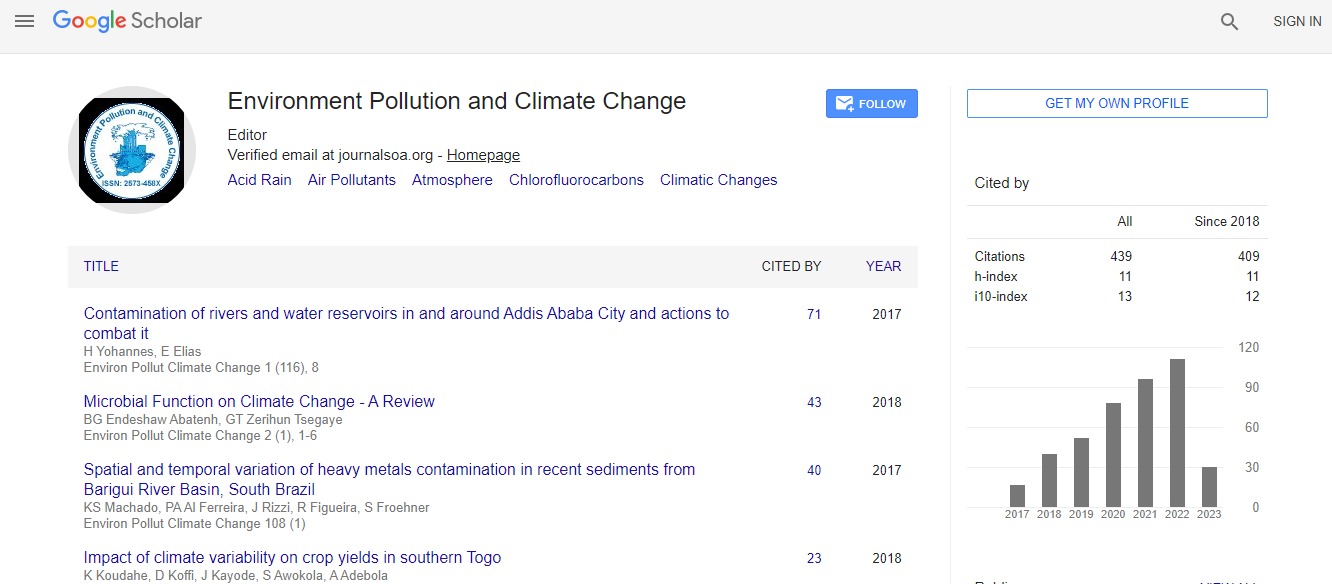Our Group organises 3000+ Global Conferenceseries Events every year across USA, Europe & Asia with support from 1000 more scientific Societies and Publishes 700+ Open Access Journals which contains over 50000 eminent personalities, reputed scientists as editorial board members.
Open Access Journals gaining more Readers and Citations
700 Journals and 15,000,000 Readers Each Journal is getting 25,000+ Readers
Google Scholar citation report
Citations : 672
Environment Pollution and Climate Change received 672 citations as per Google Scholar report
Environment Pollution and Climate Change peer review process verified at publons
Indexed In
- Google Scholar
- Publons
- Euro Pub
- ICMJE
Useful Links
Recommended Journals
Share This Page
Differences in PM2.5 from various combusted materials
Joint Event on 5th World Conference on Climate Change & 16th Annual Meeting on Environmental Toxicology and Biological Systems
Fawei Yan and Fenfen Zhu
Beijing Daxing International Airport, ChinaRenmin University of China, China
ScientificTracks Abstracts: Environ Pollut Climate Change
Abstract
PM2.5 now is a very hot topic in China and the government is taking sustained efforts to resolve this problem. Especially, in Beijing, restricting vehicles, restriction on constructions, closing low-end factories that contaminate the environment, are several means to reduce the PM2.5 generation by all respects. However, PM2.5 emerges from many sources, including natural and anthropogenic discharges. One of the main anthropogenic sources is combustion. Fuel burning is a very important source. Many researchers have deeply studied the formation of PM2.5 from coal combustion or oil combustions. However, the research on PM2.5 from other combustions is a rarity. Hence, several materials were combusted including plastic, wood and glass as the research subjects in the same operation condition in this study. These three represent three kinds of materials, chemical organic matter, organic biomass and inorganic matter. Information such as PM2.5 production and PM2.5 morphology were collected. The findings suggested that different wastes would exhibit different PM2.5 emission potentials in the same combustion operation condition and the morphologies of PM2.5 from various combustion sources is also identifiable. By weighing the filter mass increase before and after combustion, the PM2.5 yields could be calculated. Also by using SEM to analyze the PM2.5 collected on the filter, PM2.5 morphology is analyzed. Plastic combustion bears the highest PM2.5 discharge potential during incomplete burning with tremendous spherical particulates in the images. Glass bears no PM2.5 discharge potential for its incombustible properties. While wood would generate PM2.5 in an irregular shape with a moderate production. Recent Publications 1. Fenfen Zhu and Fawei Yan (2017) PM2.5 emission behavior from laboratory-scale combustion of typical municipal solid waste components and their morphological characteristics. Energy & Fuels 111:855-876. 2. Fawei Yan and Fenfen Zhu (2016) Preliminary study of PM2.5 formation during municipal solid waste incineration. Procedia Environmental Sciences 31:475–481.Biography
Fawei Yan, studied his Masters of Engineering in School of Natural Resources and Environment, Renmin University of China, majoring in Environmental Science from 2014 to 2017. During school time (2010-2017), he participated in many research programs, for example, PM2.5 Formation, Lignocellulose Degradation (Microorganism), Waste Combustion, Soil Analysis and so on. Especially, he took part in the research Antibiotics Degradation in Water in University of Nebraska Lincoln, USA for almost 2 months in 2013. Now he work in the Planning and Development Department, Beijing New International Airport. He has his expertise in Environment Research such as PM2.5, waste combustion. His research interests are PM2.5 Generation and Green Airport.
E-mail: 314189502@qq.com

 Spanish
Spanish  Chinese
Chinese  Russian
Russian  German
German  French
French  Japanese
Japanese  Portuguese
Portuguese  Hindi
Hindi 
